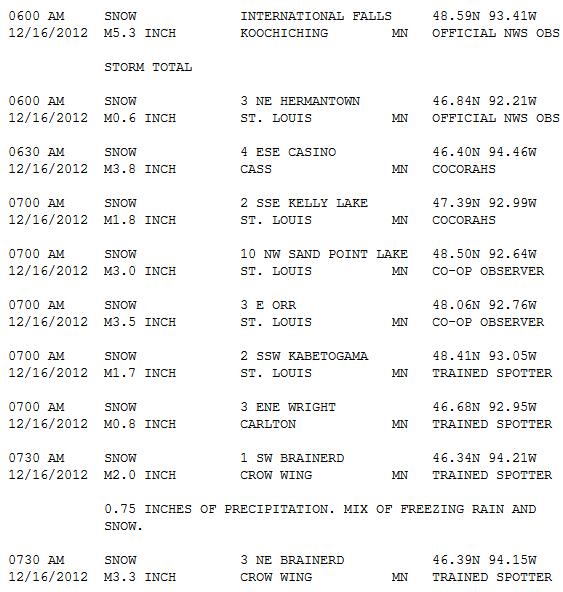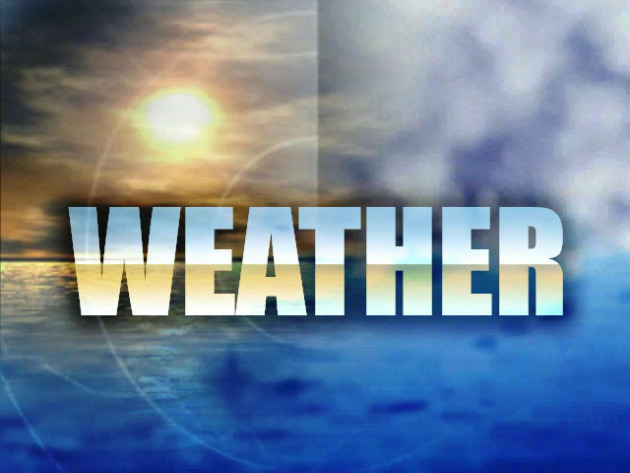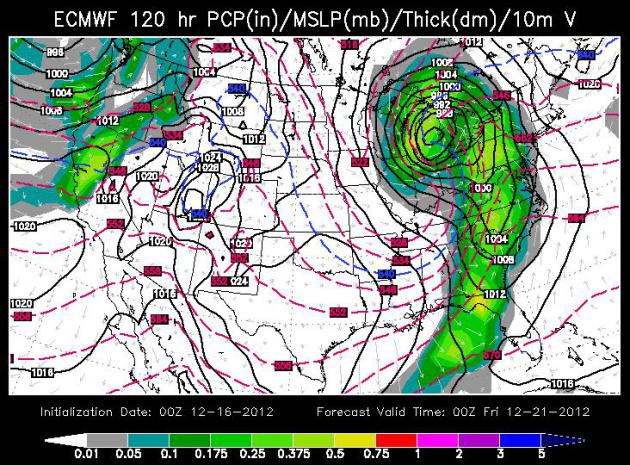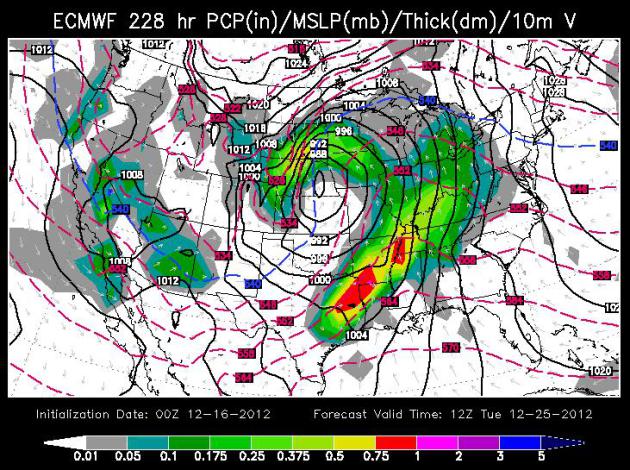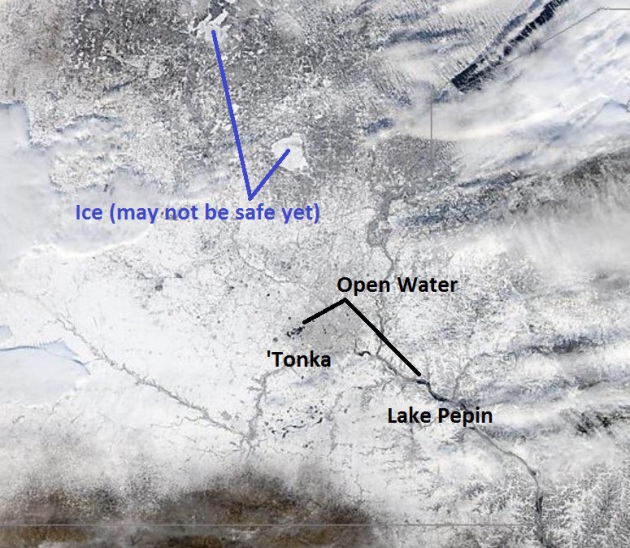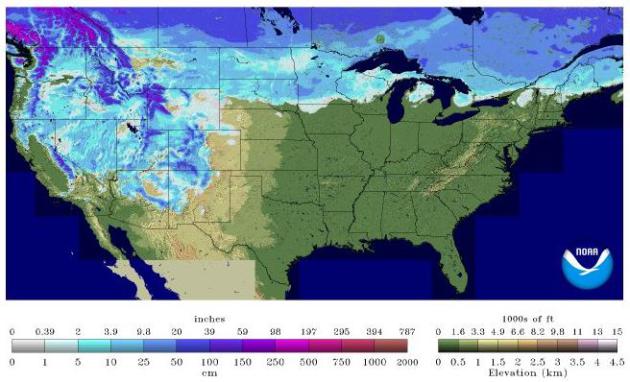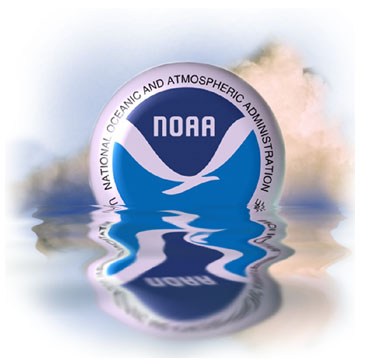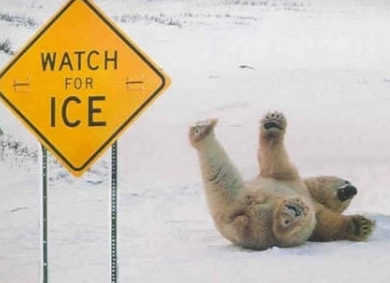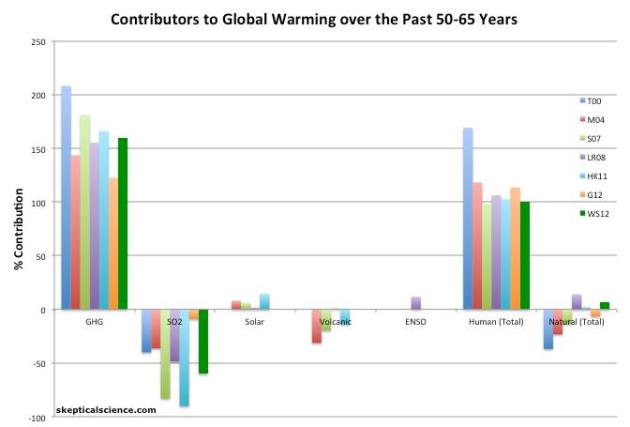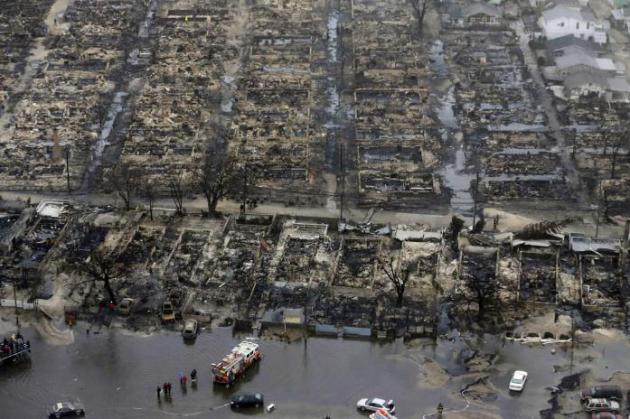"March-ember"
With all the unsettling weather of recent years,
were you really surprised it rained yesterday, 6 days before the Winter
Solstice?
Me neither.
2012: probably the warmest on record for
Minnesota. Flowers blooming in March. July was the second warmest month
since 1872. Only one month the entire year was cooler than average
(October).
A foot of snow a week ago was reassuring (for winter fans) but the patient continues to run a low-grade fever.
So what?
Think how a couple of extra degrees can leave
you feeling miserable, with flu and aches.
2012 may wind up 5 F. warmer
than average in the Twin Cities. The Symphony of The Seasons is still
playing slightly out of tune - that's why the snow in your yard
yesterday looked like week-old oatmeal.
Flurries taper; a few lucky towns having picked
up 1-2 inches of snow overnight. Skies clear later today; seasonably
chilly weather into midweek. Thursday's storm will probably track south
and east of Minnesota, dumping heavy snow from the Quad Cities to
Madison and Green Bay. Cold, dry weather prevails from Friday into
Christmas (teens and 20s for highs - lows in single digits).
Here we go, stumbling into another abbreviated Minnesota winter.
Saturday Snowfall. Although
just about all rain in the Twin Cities, Brainerd picked up a 2-4" icy
mix of freezing rain followed by snow. Over 5" of new snow caked
International Falls. More details from NOAA
here.
328 Days without a Sub-Zero Temperature in Rochester MN – All Time Record in Jeopardy. Rochester
International Airport has not fallen below zero since January 21 2012
-12 degrees. This 328 day stretch ties a similar stretch in 1999
January 26-December 19 for the third longest stretch of days without
falling below zero. This current streak is just 5 days from the record
of 333 days set back in 1987 January 27 through December 25. With no
sub-zero temperatures in forecast for next week, this record will
likely bebroken on Thursday, December 20th. Source: NOAA.
ECMWF: Quiet Week.
The latest European model shows a few flurries by Wednesday,
substantially colder weather by next weekend with highs in the teens and
low 20s. Thursday's storm is a no-show, sliding off south/east of MSP.
Big Snow for Chicago? Not Here.A
very significant storm spins up later this week, along the leading edge
of a colder surge. Heavy snow is possible from the Quad Cities to
Madison, Milwaukee and Chicago by Thursday, a warm rain (and a few
severe T-storms) pushing into the eastern seaboard? Like something out
of March. ECMWF Map: valid Thursday evening, courtesy of WSI
Christmas Slush. It's pretty far
out on the horizon, but just for laughs and giggles I thought I'd
include the outlook for Christmas Morning, showing a possible severe
T-storm outbreak from Dallas and Houston to Memphis, with a storm
winding up over the Upper Midwest, possibly a rain/snow mix for much of
Minnesota, with heavier snow (only) for the Dakotas - a rather turbulent
map,and if it verifies, weather will almost certainly be a factor for
Christmas travel. 12z December 25 ECMWF (European) map from WSI.
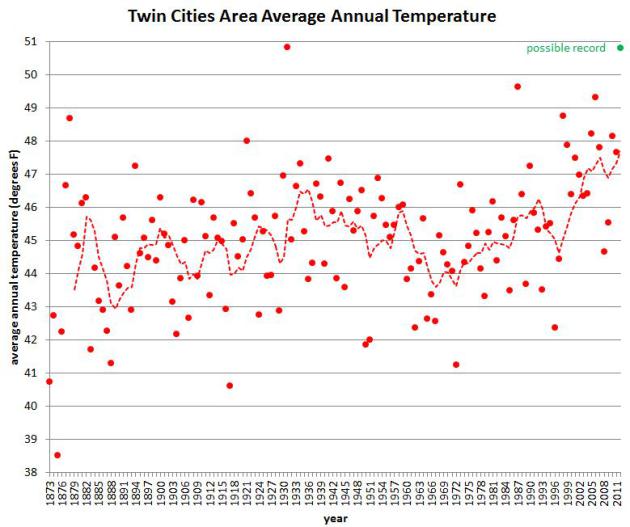
2012: Warmest Year On Record for the Twin Cities? Here's an excerpt of an e-mail I received from Minnesota State Climatologist Greg Spoden: "As
I'm sure you are aware, Twin Cities temperatures in 2012 have been
pervasively warm. March 2012 was the warmest March on record by a large
margin. July 2012 was the second warmest July (and the second warmest of
any month) of the modern record. October was the only below-normal
temperatures month of the year. As the calendar year comes to a close,
there exists the potential to break the record for the warmest annual
average temperature found in the modern Twin Cities climate data set
(1872-2012). Should the December monthly average temperature finish
above 24.0 degrees, a new calendar year average temperature record will
be established. This will require that the monthly average temperature
exceeds the December normal average temperatures (19.7 degrees) by more
than 4.3 degrees. Given December temperatures reported thus far, along
with the outlooks for the second half of December, such a scenario
appears to be plausible."
Graphic above: average Twin Cities temperatures since 1872, courtesy of the Minnesota Climate Office.
Drought Details. Dr. Mark Seeley has more details about Minnesota's ongoing drought in this week's edition of
Minnesota WeatherTalk; here's an excerpt: "
The weekly Drought Update from Brad Rippey with the USDA World Agricultural Outlook Board includes the following comments:
-The portion of the contiguous U.S. in the worst category – D4, or
exceptional drought – remained virtually unchanged at 6% (rounded) for
the eighteenth consecutive week (August 14 – December 11).
-Hay in drought fell slightly to 64%, but has been at or above 60% for 23 consecutive weeks – since July 10.
-Cattle in drought was unchanged at 73%, and has been greater than
two-thirds of the domestic inventory for 23 consecutive weeks (July 10 –
December 11).
-Winter wheat in drought was down slightly to 63%, although the hard
red winter wheat belt – especially from South Dakota to Texas – remains
deeply entrenched in drought."
* the latest Minnesota Drought Monitor from NOAA is
here.
2012: Probably The Warmest Year In Recorded U.S. History. Here are a few bullet points from
NOAA NCDC:
- The January-November period was the warmest first 11 months of
any year on record for the contiguous United States. The national
temperature of 57.1°F was 3.3°F above the 20th century average, and
1.0°F above the previous record warm January-November of 1934. During
the 11-month period, 18 states were record warm and an additional 24
states were top ten warm.
- It appears virtually certain that 2012 will surpass the current
record (1998, 54.3°F) as the warmest year for the nation. December 2012
temperatures would need to be more than 1.0°F colder than the coldest
December (1983) for 2012 to not break the record.
Unstable Ice. I can't stress enough to outdoor
enthusiasts of all ages that ice in and around the Twin Cities, even St.
Cloud, is still not even close to being "safe". Mille Lacs, Gull and
the Whitefish Chain is mostly ice-covered, but you should absolutely
check with local authorities before dragging your ice house out. NASA's
1,000 meter
MODIS satellite still showed open water on metro lakes yesterday, extending south to Mankato and Lake Pepin. Be careful out there.
Slight Shrinkage.
NOAA
data shows snow on the ground over 35.6% of the lower 48 states,
compared with 17 % of the same area a month ago, on November 13, 2012.
Many northern tier cities will see a white Christmas. The rest of the
USA? Not so much.
The Weather Cliff? New Study Warns Of Sequestration Impacts To NASA, NOAA Programs. Here's an excerpt from a post at the
Second to None web site: "
A new economic impact analysis
concludes that over 20,000 NASA contractor jobs and over 2,500 NOAA
jobs related to weather satellites could be lost in 2013 if the Budget
Control Act’s sequestration mandate takes effect on January 2, 2013.
“This report demonstrates that the biggest single threat to our space
programs’ continued success are arbitrary and capricious budget cuts,”
said AIA President and CEO Marion C. Blakey. “NASA and NOAA are
responsible for cutting edge activities that expand the boundaries of
knowledge and discovery, lead to economic innovation and save lives. We
can’t afford not to invest in these sources of American scientific
and technological greatness...”
Editorial: Why No Hurricane Warnings For Sandy? Here's a portion of an Op-Ed from
USA Today: "
When Sandy clobbered the Northeast on Oct. 29, it carried torrential rains, record flooding — and hurricane-force winds.
Gusts reached 90 mph in New York and New Jersey, 86 mph in Rhode
Island, 85 mph in Connecticut, 83 mph in Massachusetts and 81 mph in
Pennsylvania. Despite these clear-cut Category 1 conditions, however, no
hurricane watches or warnings were posted in any of those states.
OPPOSING VIEW: Our warnings were clear and effective
Why not? In the six weeks since Sandy struck, a lot of people in
the forecasting community have been asking that question. The emerging
answers suggest that, faced with a pair of unusual challenges from
Sandy, government forecasters rose to one test and bungled the other..."
Hurricane Sandy Relief Aid Already In Jeopardy In Congress. Nice of our elected representatives to turn Sandy's recovery into another political freak show; details from
MSNBC: "
President Obama has submitted a $60.4 billion relief package for areas affected by Hurricane Sandy, which is actually below the total aid request from the governors of New York, New Jersey, and Connecticut, but as promised, Congress is not in a generous mood.
House lawmakers don't intend to introduce an emergency funding
bill anywhere near as large as the $60 billion the Obama administration
is seeking to help rebuild the Northeast after superstorm Sandy,
saying the administration hasn't provided sufficient details to justify
spending that amount, two senior GOP aides said Wednesday.
If the Republican-controlled House doesn't take up the measure
this year, it would push debate on a large rebuilding bill into next
year -- something New York and New Jersey officials have said they want
to avoid..."
Photo credit: " A miniature golf course destroyed by Hurricane
Sandy at Jenkinson's Boardwalk in Point Pleasant Beach, N.J., Nov. 28,
2012. A month after Hurricane Sandy wreaked havoc along the Jersey
Shore, the area is slowly starting to recover. (Fred R. Conrad/The New
York Times)
Climate Stories...
Extreme Weather More Persuasive On Climate Change Than Scientists.
Some people may not believe peer-reviewed science, but it appears they
do believe their own eyes (and personal experiences). Here's an excerpt
from
The Guardian: "
As
one of the Marx brothers famously said: who do you believe, me or your
own eyes? Climate sceptics, it turns out, are much more likely to
believe direct evidence of a changing climate in the form of extreme
weather events than they do scientists, when it comes to global
warming. A poll released on Friday by the Associated Press-GfK found rising concern about climate change
among Americans in general, with 80% citing it as a serious problem
for the US, up from 73% in 2009. Belief and worry about climate change
were rising faster still among people who do tend not to trust
scientists on the environment..."
Photo credit: "
Homes left in the wake of superstorm Sandy in Seaside Heights, New Jersey." Photograph: Mike Groll/AP
AP-Gfk Poll: Belief In Climate Change Rises With Thermometers, Even Among US Science Doubters. Here's an excerpt from an
Associated Press Gfk poll: "
Nearly
4 out of 5 Americans now think temperatures are rising and that global
warming will be a serious problem for the United States if nothing is
done about it, a new Associated Press-GfK poll finds. Belief and worry
about climate change are inching up among Americans in general, but
concern is growing faster among people who don’t often trust scientists
on the environment. In follow-up interviews, some of those doubters
said they believe their own eyes as they’ve watched thermometers rise,
New York City subway tunnels flood, polar ice melt and Midwestern farm
fields dry up...."
IPCC Draft Report Leaked: Shows Global Warming Is NOT Due To The Sun.
More on the leaking of the upcoming IPCC report, how it's being spun by
the Climate Denial Machine, and what it really says, at
Skeptical Science; here's an excerpt: "
Alec Rawls,
an occasional guest poster on the climate contrarian blog
WattsUpWithThat who signed up to review the upcoming Intergovernmental
Panel on Climate Change (IPCC) Fifth Assessment Report (as anyone can), has "leaked" a draft version of the report and declared that it "contains game-changing admission of enhanced solar forcing." This assertion was then repeated by James Delingpole at The Telegraph
(with some added colorful language), and probably on many other climate
contrarian blogs. If the IPCC were to report that the sun is a
significant player in the current rapid global warming, that would
indeed be major news, because the body of peer-reviewed scientific literature and data clearly show that the sun has made little if any contribution to the observed global warming over the past 50+ years..."
Image credit above: "
Percent
contributions of greenhouse gases (GHGs), sulfur dioxide (SO2), the
sun, volcanoes, and El Niño Southern Oscillation (ENSO) to the observed
global surface warming over the past 50-65 years according to Tett et al. 2000 (T00, dark blue), Meehl et al. 2004 (M04, red), Stone et al. 2007 (S07, green), Lean and Rind 2008 (LR08, purple), Huber and Knutti 2011 (HK11, light blue), Gillett et al. 2012 (G12, orange), and Wigley and Santer 2012 (WS12, dark green)."
Early Draft Of International Climate Science Report Posted Online. More on the apparent leak of a (preliminary) IPCC report, due out next September, from
The Union of Concerned Scientists; here's an excerpt: "
Yesterday,
a blogger who had signed up to review a forthcoming Intergovernmental
Panel on Climate Change (IPCC) report on climate science posted unauthorized drafts online.
Below is a statement by Peter Frumhoff, Science and Policy Director at
the Union of Concerned Scientists and a lead author for the IPCC’s
2007 report: “The report is a draft and will change. Overall, scientific
groups like the IPCC recognize that climate change is happening faster
and with greater consequences than previously anticipated. Whether
it’s the National Academy of Sciences or the United States Global
Change Research Program, there is, and will remain a strong scientific
basis to inform and motivate policymakers to reduce the serious risks
that climate change poses for our nation and the world..."
* Global Warming is not due to the sun, according to leaked IPCC report. The U.K. Guardian has
details.
Insurance Industry Paying Increasing Attention To Climate Change. The data is the data - the trends are the trends, as described in this excerpt from
Science Daily: "...
Weather
and climate-related insurance lossses today average $50 billion a year.
These losses have more than doubled each decade since the 1980s,
adjusted for inflation," says the study's author Evan Mills, a scientist
in Lawrence Berkeley National Laboratory (Berkeley Lab's Environmental
Energy Technologies division). "Insurers have become quite adept at
quantifying and managing the risks of climate change, and using their
market presence to drive broader societal efforts at mitigation and
adaptation...."
Libertarians, Engineers, and Climate Disruption Denial: Part 1. The psychology of denial is examined in this post at
Scholars and Rogues; here's an excerpt: "...
Ever
since I encountered my first example of a climate disruption denier
I’ve wondered what kind of person could deny the reality that is
industrial climate disruption. Over the years of writing on climate,
however, it became clear that there were two groups of people who made
up the majority of the serious deniers – libertarians and engineers of
various stripes. As an electrical engineer myself, however, I didn’t
understand how individuals trained in mathematics, science, and logic
could fail to see glaring scientific, mathematical, physical, or logical
flaws in their own arguments. Eventually, though, something clicked:
most of the engineers I work with today and have worked with since
earning my MSEE are either libertarians themselves or have some
libertarian leanings. This is the first part of a series of posts
exploring the personality traits and moral values of libertarians,
engineers, and the relationship of those traits and values to the
denial of industrial climate disruption..."
Image credit above: National Park Service, Will Elder

